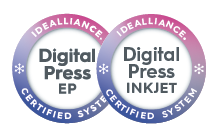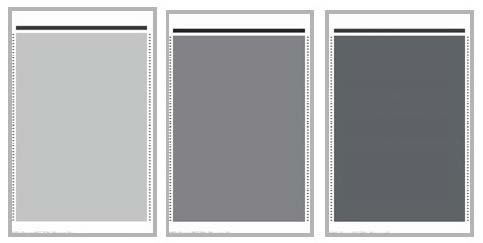The Idealliance Print Properties Committee (PPC) is a diverse group of leading color scientists and developers, manufacturers, print service providers and end users that for forty years have been defining color standards and workflows for print & packaging media. They work on initiatives to help better the graphic communications industry. The Committee has been at the core of key developments in color with an alphabet soup defining how you print today—and tomorrow including:
- G7®
- GRACoL®
- SCTV
- PRINTWIDE®
- XCMYK
- ECG 7 Color targets
- and many other tools widely used across the industry.
They also offer input for the various certifications offered by Idealliance, such as the Digital Press System Certification Program. Unlike the G7 Master Certification, Idealliance Digital Press for EP and Inkjet System Certifications are offered only to press manufacturers. This certification level requires passing a vigorous battery of tests, which include not only color fidelity to a target profile but also the ability to reproduce the same results over time and throughout the press run, the uniformity of the press sheet from side to side and leading to trailing edge along with physical aspects such as registration, image quality and rub resistance.

Idealliance Digital Press System Certification for Electrophotographic (EP) and Inkjet Presses.
The Certification procedures in this updated (v2.4) program consider advancements in ISO standards introduced since its previous publication in 2017. Test forms are updated to include the latest IT8.7/5 chart layouts and formulas used in the Uniformity M Score testing have been updated to the latest ISO technical specs. The PPC took on the task of updating the requirements for this certification document to accommodate those advancements by way of a subcommittee.
In this subcommittee, we defined three objectives.
- To see the Digital Press Certification Program document updated with new test charts, metrics and
M Score uniformity technical specs from ISO. - Specific to the M Score portion of the test, to investigate ways to improve the process and to gain
meaningful actionable data beyond a simple pass/fail. - To further investigate alternative M Score math using statistical analysis, which might provide more accuracy and actionable data.
The updated test charts and formulas are scheduled to be implemented as the Idealliance Digital Press Certification Program v.2.4., which will include new press forms along with a new pre-qualification workbook for the updated M Score Uniformity formulas. This was Objective #1 listed above.
While a manufacturer could pre-qualify themselves for most aspects of the battery of tests using commercially available color management and quality control, one measurable aspect of this battery does not seem to have been addressed by the commercial market: the M Score for Macro Uniformity. A simple workbook to calculate M Score is now included in the pre-qualification kit.
Press Sheet Macro Uniformity or M Score is an analysis of just how well a CMYK printing system works at delivering a consistent image across and along the press sheet in highlight, midtone and shadow areas. It does not look for micro or fine defects, such as pinholes, picking or missing nozzles, but rather considers horizontal and vertical spatial uniformity. The Current ISO Technical Specification (ISO 18621-21:2023) consists of measuring three digitally printed 12x18 press sheets of CMYK grays in the 20% 40% and 65% tonal ranges with 46 columns x 64 rows each, then calculating a score from 0-100 (0=Poor Uniformity, 100=Perfect uniformity) for each sheet which is called the M-Score.

M Score is calculated by averaging the Lab values of each column/row separately, then calculating the DE00 of each row and column against its neighbor row or column. These DE00 values are then averaged for the rows and columns, then the last two values are normalized and scaled into the 0-100 scoring using a specific M Score formula. An M Score is derived for each of the 3 sheets, and all 3 sheets need to score 60 or higher to pass.

20 % (C=20 MYK=15) 40% (C=40, MYK=30) AND 65% (C65, MYK50) GRAY CHARTS USED IN ISO TS 18621-21:2023 AND THE DIGITAL PRESS SYSTEM CERTIFICATIO V2.4
The test sheets are designed to be measured using a specific instrument, the xRite iSisXL scanning spectrophotometer at 6mm pitch left/right and top/bottom. This can be cumbersome in a production environment, as each 12x18 sheet has 2944 data points, and all 3 must be measured to calculate the M Scores. Also, M Score provides no feedback as to what might be causing poor scores. It’s a simple pass/fail test.
Seeing M Score being used as a quality control metric is rare in commercial environments. In fact, many seasoned color management professionals are unaware of its existence. All, however, have experienced streaking or banding in digital press environments. M Score is simply a way to quantify those press sheet artifacts.
There may be multiple reasons that M Score as a QC metric has been avoided by the commercial market. It is a pass/fail score which offers no insight into what might be causing a lack of press sheet uniformity. Streaking and banding in digital printing are common, and trying to keep a commercial system in show-room condition is not economically feasible. This pass/fail test is likely too strict a requirement with no immediate resolution offered for commercial operators. Increased service calls and parts replacement would have a negative impact on manufacturers’ profitability and the tools required may not be available in many shops. Advancements in the ink delivery process, such as direct inkjet have lessened, but not eliminated, streaking and banding artifacts.